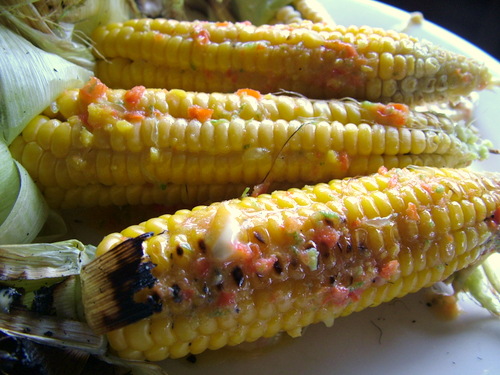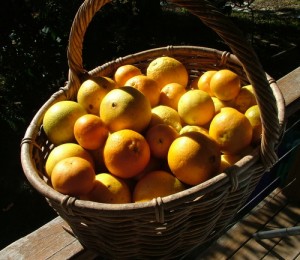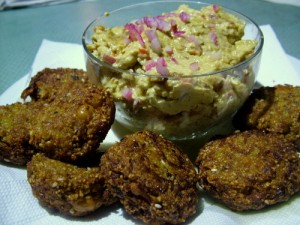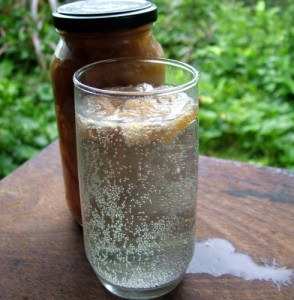My glut crop this week is sweet corn – the last round of sweet corn for the year. Sweet corn is one of the trickier crops for a home gardener. What goes wrong?
It can fail to pollinate if there are too few plants in a block – the pollen from the flowers on one plant must fall onto the silks on a corn cob on a neighbouring plant for it to set seed. Otherwise you get odd looking cobs with only a few kernels. Warm dry weather at pollination time, and enough plants all bunched together to get a nice mist of pollen in the air is ideal. But to have a serious block of corn plants close enough together to get good pollination takes a serious amount of soil nutrients (specially nitrogen) and water. It is also a C4 plant, so one one of the few garden crops that can use all the sun you can give it.
The other problem with a serious block of corn plants is that you get a lot of sweet corn, all at once. Luckily corn on the cob is made for barbecues.
The Recipe:
Pick the corn as close as possible to eating time. As soon as you pick it, it begins turning sugars into starch.
Soak the cobs, husk and all, in a sink or a bucket of water for a few minutes, just to get the husk wet all the way through. Then put the cobs, in their husk, on a hot barbecue. Cook, turning with tongs, for about 15 minutes till the outer layer of the husk is charred and the corn is hot all the way through.
Provide salt, pepper, butter, lime juice, and finely grated cheese for dressing. My favourite dressing is Chili Lime Butter, below, and this is the only few weeks of the year when chilis, limes, and sweet corn are all in season together.
Chili Lime Butter
Blend together equal amounts of butter and olive oil. Blend in chili, lime juice, lime zest, and salt to taste. I like about one lime (juice and zest) and two medium chilis to each cup of butter-olive oil mix, but just keep adding and tasting till you get it to your taste.




I love this recipe because it is one of those that uses what we are harvesting right now. What food grows with, goes with.
It’s amazing that, isn’t it Tanya, how many foods taste great together grow together – like basil and tomatoes or broccoli and lemon.
My mouth is watering. Thanks for the growing tips, I have never had much corn success. And I never knew it was a C4 – very handy information.
I love corn. I have just started harvesting mine (a whole 4 cobs so far) and I was wondering why there were a few little tiny cobs that weren’t properly formed with just a few kernels so your post explained that. I thought corn put nitrogen into the soil but do you also need to give them lots as well when they are growing? I will definitely make the chilli lime butter.
Hi Kate,
corn isn’t a legume, so it doesn’t fix nitrogen out of the atmosphere the way beans and peas do. It would add some nitrogen in the form of the spent stalks dug back in, but that would be what was added in the first place, minus what came out in the form of corn cobs. And it’s a pretty heavy feeder, so it likes lots of compost and fairly rich soil. Being a C4 plant means that it is capable of using lots of carbon dioxide if all the other stuff it needs to grow are there to match it. Commercially grown corn is one of the big users of nitrogen fertilizers worldwide, and urea, ammonium sulphate, ammonium nitrate, anhydrous ammonia – all the forms of nitrogen fertilizer, are made by a process called the Haber-Bosch process, which uses natural gas as it’s main raw material. A significant percentage of the world’s natural gas production is used in the process, making it a significant contributor to greenhouse gases, and a big market driver for coal seam gas mining. Yet another reason to avoid all the high fructose corn syrup products.
I’ve nearly given up on corn. I seem to get something wrong every time I grow it whether it’s the nutrient demands or block size or the ever-unpredictable weather. That Chilli-lime butter sounds pretty tantalising though.
Hi Linda
Thanks for the info. I had noticed that some of the strawberry growers up here (Sunshine Coast) plant corn after the strawberries are finished so I made this false assumption about nitrogen fixing – clearly I am not a scientist!! I have got a reasonable amount of compost in my corn clumps but I’ll go and brave the dynamic lifter today. I have also planted a few beans around the corn so hopefully they will help the corn. Thanks for the info about the gas process – seems corn syrup products are bad for lots of reasons – including obesity I suspect,